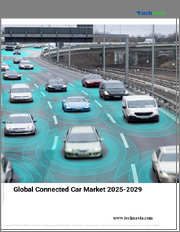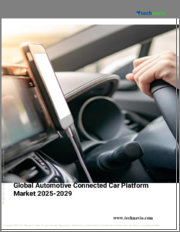
|
시장보고서
상품코드
1716263
아시아태평양의 커넥티드카 시장 : 용도별, 차종별, 네트워크 유형별, 판매채널별, 형태별, 트랜스폰더별 하드웨어별, 국가별 - 분석과 예측(2024-2034년)Asia-Pacific Connected Car Market: Focus on Application, Vehicle Type, Network Type, Sales Channel, Form, Transponder, Hardware, and Country-Level Analysis - Analysis and Forecast, 2024-2034 |
||||||
아시아태평양의 커넥티드카 시장 규모는 2024년 392억 7,000만 달러에서 2034년에는 2,334억 1,000만 달러에 달하며, 예측 기간의 2024-2034년 CAGR은 19.51%에 달할 것으로 예측됩니다.
최첨단의 안전성, 인포테인먼트, 텔레매틱스 솔루션에 대한 고객의 요구가 증가하면서 아시아태평양에서 C-V2X 통신, AI 기반 모빌리티 서비스, 5G 네트워크의 급속한 도입이 가속화되고 있습니다. 아시아태평양 OEM 및 차량 운영업체들은 정부의 안전 규제, 도시화, 전동화 및 자율주행에 대한 야심찬 목표에 대응하기 위해 채택을 가속화하고 있으며, Toyota, Hyundai, Honda, Denso와 같은 유명 기업 및 신생 디지털 스타트업은 스마트 텔레매틱스, 연계 모빌리티 플랫폼, 무선 소프트웨어 업데이트에 많은 투자를 하고 있습니다. 전략적 민관 협력, 국가적 스마트 시티 구상, 5G 인프라 구축 등의 지원으로 아시아태평양은 서비스형 모빌리티(MAAS)와 차세대 차량 연결의 발전에서 세계 중심지로 자리매김하고 있습니다.
| 주요 시장 통계 | |
|---|---|
| 예측 기간 | 2024-2034년 |
| 2024년의 평가 | 392억 7,000만 달러 |
| 2034년 예측 | 2,334억 1,000만 달러 |
| CAGR | 19.51% |
급속한 도시화, 5G 인프라의 성장, 첨단 모빌리티 솔루션에 대한 소비자 수요 증가가 아시아태평양의 커넥티드 자동차 시장을 주도하고 있습니다. 인포테인먼트, 텔레매틱스, 예지 정비, 실시간 내비게이션, V2X(Vehicle-to-Everything) 연결 등의 기술을 통해 이 지역의 커넥티드카는 운전 효율성, 안전성, 편의성을 향상시키고 있습니다.
중국, 일본, 한국, 인도 등의 국가들은 스마트 모빌리티, 교통안전, 배기가스 감축을 장려하는 강력한 정부 프로그램의 지원을 받아 커넥티드 기술 도입에 앞장서고 있습니다. 변화하는 시장 요구에 대응하기 위해 OEM과 기술 프로바이더들은 OTA(Over-The-Air) 업데이트 기능, 소프트웨어 정의 차량, AI 기반 텔레매틱스에 많은 투자를 하고 있습니다. 소비자, 인프라, 자동차를 연결하는 통합 디지털 생태계에 대한 수요는 전기자동차(EV)의 인기가 높아지면서 더욱 증가하고 있습니다.
시장 전망은 여전히 좋지만, 규제 프레임워크의 불일치, 사이버 보안 위협, 농촌과 도시의 불균등한 연결 등의 문제가 여전히 남아 있습니다. 또한 특히 신흥 경제국에서는 구매하기 쉬운 가격에 대한 우려도 보급에 영향을 미치고 있습니다. 그러나 민관 협력의 지속, 5G 도입의 개선, 자율 및 공유 교통 솔루션에 대한 관심 증가로 인해 향후 수년간 아시아태평양은 차세대 커넥티드 모빌리티 기술의 세계 중심지로 자리매김할 것으로 예측됩니다.
아시아태평양 커넥티드카 시장 동향과 추진 요인 및 과제
동향
아시아태평양의 커넥티드카 시장은 5G 커넥티비티, C-V2X 통신, AI 기반 텔레매틱스, 클라우드 기반 인포테인먼트 시스템의 도입으로 빠르게 성장하고 있습니다. 스마트 교통 솔루션의 대규모 배포와 자율주행차 개발에 대한 대규모 투자는 중국, 일본, 한국, 인도 등의 국가들이 주도하고 있습니다. 소프트웨어 정의 차량 아키텍처는 예지 정비, OTA(Over-the-Air) 업데이트, 개인화된 차량내 서비스 제공이 가능해지면서 인기를 끌고 있습니다. 전기자동차(EV)의 성장으로 인해 사용자 경험과 업무 효율성을 향상시키는 통합 디지털 생태계에 대한 수요가 더욱 증가하고 있습니다.
성장 촉진요인
이 지역의 주요 요인으로는 급속한 도시화, 교통안전 개선에 대한 수요 증가, 정부 주도의 스마트 시티 프로젝트, ADAS(첨단 운전자 보조 시스템), 긴급 신고 기능, 공해 감시를 의무화하는 엄격한 규제로 인해 기술 도입이 가속화되고 있습니다. 스마트폰 보급 확대, 5G 인프라 개발, 커넥티드 라이프스타일에 대한 소비자의 기대치 증가 등의 요인으로 인해 OEM은 디지털 기능을 최우선 순위에 두어야 합니다. 또한 아시아태평양에서 지능형 교통시스템 및 V2I(Vehicle-to-Infrastructure) 프로젝트가 대규모로 추진되고 있으며, 민관 파트너십을 통해 이러한 프로젝트가 장려되고 있습니다.
과제
주요 장애물로는 서로 다른 법제도, 고가의 연동 장비, 국가별로 다른 5G 네트워크 커버리지 등을 들 수 있습니다. 표준화된 통신 방식의 부재, 사이버 보안 위험, 데이터 프라이버시 문제는 원활한 연결성을 저해하고 있습니다. 또한 아시아태평양의 개발도상국에서는 가격에 민감한 고객들 사이에서 가격 설정이 보급을 저해하는 요인으로 작용하고 있습니다.
이 보고서는 아시아태평양의 커넥티드카 시장에 대한 상세 인사이트를 제공하여 정보에 입각한 의사결정과 전략 수립을 가능하게 함으로써 조직에 부가가치를 창출할 수 있도록 도와줍니다. 새로운 기술, 시장 동향, 경쟁 역학에 대한 인사이트를 제공하여 기업이 성장 기회를 파악하고, 업계 수요에 맞게 제품을 조정할 수 있도록 돕습니다. 이 보고서의 상세한 세분화 및 지역 분석은 타겟팅된 시장 진출 전략을 지원하고, 규제 프레임워크와 사이버 보안 조치를 포괄하여 진화하는 업계 표준을 준수할 수 있도록 보장합니다. 이 보고서를 통해 기업은 혁신을 촉진하고, 업무 효율성을 개선하며, 빠르게 진화하는 커넥티드 모빌리티 생태계에서 경쟁력을 확보하고, 지속가능한 성장과 기술 리더십을 확보할 수 있습니다.
아시아태평양의 커넥티드카 시장에 대해 조사했으며, 시장의 개요와 용도별, 차종별, 네트워크 유형별, 판매채널별, 형태별, 트랜스폰더별 하드웨어별, 국가별 동향 및 시장에 참여하는 기업의 개요 등을 제공하고 있습니다.
목차
개요
제1장 시장
- 동향 : 현재 및 미래에 대한 영향 평가
- 공급망의 개요
- 연구개발 리뷰
- 규제 상황
- 이해관계자 분석
- 주요 이벤트의 영향 분석
- 시장 역학 : 개요
제2장 지역
- 지역의 요약
- 아시아태평양
- 지역 개요
- 시장 성장 촉진요인
- 시장 성장 억제요인
- 용도
- 제품
- 아시아태평양(국가별)
제3장 시장 - 경쟁 벤치마킹과 기업 개요
- 향후 전망
- 지역적 평가
제4장 조사 방법
KSA 25.05.20Introduction to Asia-Pacific Connected Car Market
The Asia-Pacific connected car market is projected to reach $233.41 billion by 2034 from $39.27 billion in 2024, growing at a CAGR of 19.51% during the forecast period 2024-2034. Growing customer demand for cutting-edge safety, infotainment, and telematics solutions is driving the Asia-Pacific region's rapid adoption of C-V2X communication, AI-driven mobility services, and growing 5G networks. In response to government safety regulations, growing urbanisation, and ambitious goals for electrification and autonomous driving, OEMs and fleet operators throughout Asia-Pacific are speeding up adoption. Prominent corporations including Toyota, Hyundai, Honda, Denso, and up-and-coming digital startups are making significant investments in smart telematics, linked mobility platforms, and over-the-air software updates. With the help of strategic public-private collaborations, national smart city initiatives, and the construction of 5G infrastructure, Asia-Pacific is establishing itself as a global centre for advancements in mobility-as-a-service (MAAS) and next-generation vehicle connection.
Market Introduction
| KEY MARKET STATISTICS | |
|---|---|
| Forecast Period | 2024 - 2034 |
| 2024 Evaluation | $39.27 Billion |
| 2034 Forecast | $233.41 Billion |
| CAGR | 19.51% |
Rapid urbanisation, growing 5G infrastructure, and growing consumer demand for cutting-edge mobility solutions are driving the connected automobile market in Asia-Pacific (APAC). With technologies like infotainment, telematics, predictive maintenance, real-time navigation, and vehicle-to-everything (V2X) connection, connected cars in the area improve driving efficiency, safety, and convenience.
With the help of robust government programs encouraging smart mobility, road safety, and emissions reduction, nations like China, Japan, South Korea, and India are spearheading the adoption of linked technologies. To meet changing market needs, OEMs and technology providers are making significant investments in over-the-air (OTA) update capabilities, software-defined vehicles, and AI-powered telematics. The demand for integrated digital ecosystems that link consumers, infrastructure, and cars is being further fuelled by the rising popularity of electric vehicles (EVs).
The market prognosis is still favourable, but there are still issues including disparate regulatory frameworks, cybersecurity threats, and uneven connection in rural and urban areas. Concerns about affordability also affect widespread adoption, particularly in developing APAC economies. However, it is anticipated that in the upcoming years, APAC will be positioned as a global centre for next-generation connected mobility technologies due to continued public-private collaborations, improvements in 5G implementation, and a growing emphasis on autonomous and shared transportation solutions.
Market Segmentation
Segmentation 1: by Application
- Mobility Management
- Telematics
- Infotainment
- Driver Assistance
- Navigation
- Others (eCall, Autopilot, Remote Diagnostics, Home Integration)
Segmentation 2: by Vehicle Type
- Internal Combustion Engine (ICE) Vehicle
- Battery Electric Vehicle (BEV)
- Hybrid Electric Vehicle (HEV)
- Plug-in Hybrid Electric Vehicle (PHEV)
Segmentation 3: by Network Type
- Operational Data
- Dedicated Short-Range Communication (DSRC)
- Cellular
- Satellite
Segmentation 4: by Sales Channel
- Original Equipment Manufacturer (OEM)
- Aftermarket
Segmentation 5: by Form
- Embedded
- Integrated
Segmentation 6: by Transponder
- Onboard Unit
- Roadside Unit
Segmentation 7: by Hardware
- Head Unit
- Central Gateway
- Intelligent Antennas
- Electronic Control Unit (ECU)
- Telematics Control Unit
- Keyless Entry System
- Sensors
Segmentation 8: by Region
- Asia-Pacific (China, Japan, India, South Korea, and Rest-of-Asia-Pacific)
APAC Connected Car Market Trends, Drivers and Challenges-
Trends
The APAC connected car market is fast expanding with the incorporation of 5G connectivity, C-V2X communication, AI-driven telematics, and cloud-based infotainment systems. Large-scale rollouts of smart transportation solutions and significant investments in autonomous vehicle development are being spearheaded by nations like China, Japan, South Korea, and India. Because they enable predictive maintenance, over-the-air (OTA) updates, and personalised in-car services, software-defined vehicle architectures are gaining popularity. Demand for integrated digital ecosystems that improve user experience and operational efficiency is being further bolstered by the growth of electric vehicles (EVs).
Drivers
Key factors in the area include the region's rapid urbanisation, rising need for improved road safety, and government-led smart city projects. Technology adoption is being accelerated by strict regulations requiring advanced driver-assistance systems (ADAS), emergency call capabilities, and pollution monitoring. OEMs are being pressured to give digital features top priority due to factors like growing smartphone adoption, developing 5G infrastructure, and growing consumer expectations for connected lifestyles. Large-scale implementation of intelligent transport systems and vehicle-to-infrastructure (V2I) projects throughout Asia Pacific is also being encouraged by public-private partnerships.
Challenges
Major obstacles include disparate legislative regimes, expensive linked devices, and uneven 5G network coverage across nations. The absence of standardised communication methods, cybersecurity risks, and data privacy issues impede smooth connectivity. Furthermore, in developing APAC nations, pricing continues to be a deterrent to wider adoption among price-conscious customers.
How can this report add value to an organization?
This report adds value to an organization by providing in-depth insights into the APAC connected car market, enabling informed decision-making and strategic planning. It highlights emerging technologies, market trends, and competitive dynamics, helping organizations identify growth opportunities and align their offerings with industry demands. The report's detailed segmentation and regional analysis support targeted market entry strategies, while its coverage of regulatory frameworks and cybersecurity measures ensures compliance with evolving industry standards. By leveraging this report, organizations can drive innovation, enhance operational efficiency, and gain a competitive edge in the rapidly evolving connected mobility ecosystem, ensuring sustainable growth and technological leadership.
Table of Contents
Executive Summary
Scope and Definition
1 Markets
- 1.1 Trends: Current and Future Impact Assessment
- 1.1.1 Increasing Consumer Focus on Enhanced Anti-Theft Solutions
- 1.1.2 Growing Popularity of Usage-Based Insurance (UBI)
- 1.2 Supply Chain Overview
- 1.2.1 Value Chain Analysis
- 1.2.2 Pricing Forecast
- 1.3 Research and Development Review
- 1.3.1 Patent Filing Trend (by Country and Company)
- 1.4 Regulatory Landscape
- 1.5 Stakeholder Analysis
- 1.5.1 End User and Buying Criteria
- 1.6 Impact Analysis for Key Events
- 1.6.1 COVID-19
- 1.6.2 Russia/Ukraine War
- 1.7 Market Dynamics: Overview
- 1.7.1 Market Drivers
- 1.7.1.1 Integration of Advanced Mobility Solutions
- 1.7.1.2 Growing Demand for Premium Vehicles Owing to Inclination of Consumers toward Comfort and Luxury
- 1.7.2 Market Restraints
- 1.7.2.1 Lack of Connectivity Infrastructure to Restrain Growth
- 1.7.2.2 Challenges in Ensuring Data Privacy and Security
- 1.7.3 Market Opportunities
- 1.7.3.1 Integration with Home Automation Systems
- 1.7.3.2 Leveraging Data for Monetization Opportunities
- 1.7.1 Market Drivers
2 Region
- 2.1 Regional Summary
- 2.2 Asia-Pacific
- 2.2.1 Regional Overview
- 2.2.2 Driving Factors for Market Growth
- 2.2.3 Factors Challenging the Market
- 2.2.4 Application
- 2.2.5 Product
- 2.2.6 Asia-Pacific (by Country)
- 2.2.6.1 China
- 2.2.6.1.1 Application
- 2.2.6.1.2 Product
- 2.2.6.2 Japan
- 2.2.6.2.1 Application
- 2.2.6.2.2 Product
- 2.2.6.3 India
- 2.2.6.3.1 Application
- 2.2.6.3.2 Product
- 2.2.6.4 South Korea
- 2.2.6.4.1 Application
- 2.2.6.4.2 Product
- 2.2.6.5 Rest-of-Asia-Pacific
- 2.2.6.5.1 Application
- 2.2.6.5.2 Product
- 2.2.6.1 China
3 Markets - Competitive Benchmarking & Company Profiles
- 3.1 Next Frontiers
- 3.2 Geographic Assessment
4 Research Methodology
- 4.1 Data Sources
- 4.1.1 Primary Data Sources
- 4.1.2 Secondary Data Sources
- 4.1.3 Data Triangulation
- 4.2 Market Estimation and Forecast



















